Small electronics, including smartwatches, mobile phones, and fitness trackers, aren’t easily dismantled and recycled. This results in the explosive growth of electronic waste that is hazardous to the environment and human health. Many millions of tons of electronics waste are discarded annually, with the vast majority ending up in landfills and on scrap heaps.
Researchers at China’s Tianjin University have developed a two-metal nanocomposite for circuits that disintegrate when submerged in water to simplify small electronics recycling. They demonstrated the circuits in a prototype transient device – a functional smartwatch that dissolved within 40 hours.
Previously Xian Huang and colleagues developed a zinc-based nanocomposite that dissolved in water for use in temporary circuits but was not conducive enough for consumer electronics. The researchers modified the zinc nanocomposite by adding silver nanowires to it, which made it highly conductive.
They then screen-printed the metallic solution onto pieces of polyvinyl alcohol, a polymer that degrades in water, and solidified the circuits by applying small drops of water that facilitate chemical reactions and then evaporate.
Using this method, the team fabricated a smartwatch with multiple nanocomposite printed circuit boards inside a 3D printed polyvinyl alcohol shell. This smartwatch is fully functional, as it has sensors to measure a person’s heart rate, blood oxygen levels, and step count, and send the information to a cellphone app via a Bluetooth connection, with one important difference: it dissolves in water.
According to the team’s reports, the outer package held up to sweat during the tests, but once the entire device was fully immersed in water, both the polymer case and circuits dissolved completely within 40 hours. All that was left behind were the watch’s components, such as an organic light-emitting diode (OLED) screen and microcontroller, as well as resistors and capacitors that had been integrated into the circuits.
The researchers suggest that the two-metal nanocomposite they presented can be used to produce transient devices, with performance that matches that of commercial models, which could go a long way toward solving the challenges of small electronics waste.
